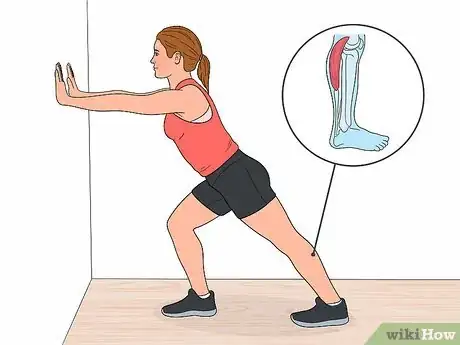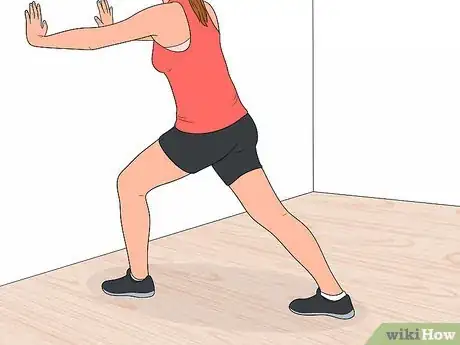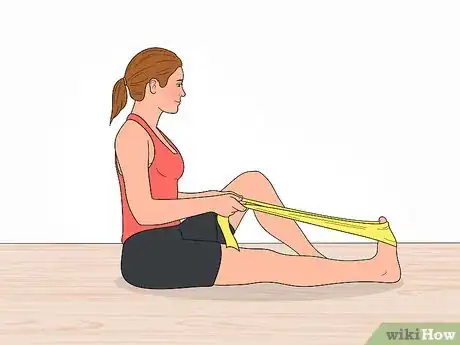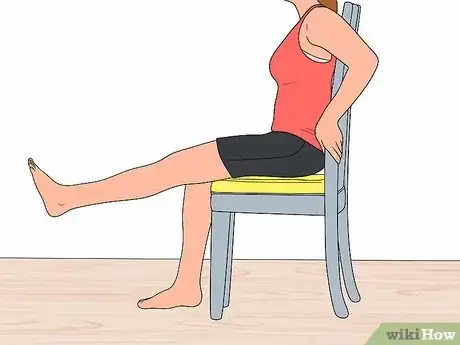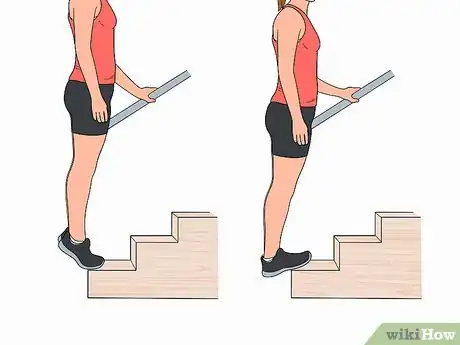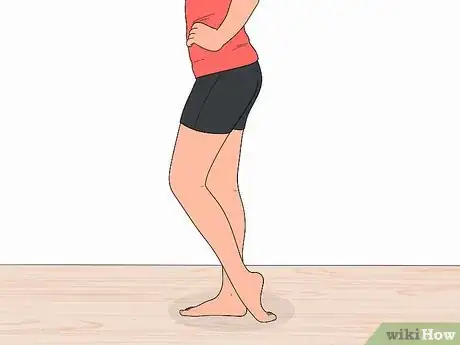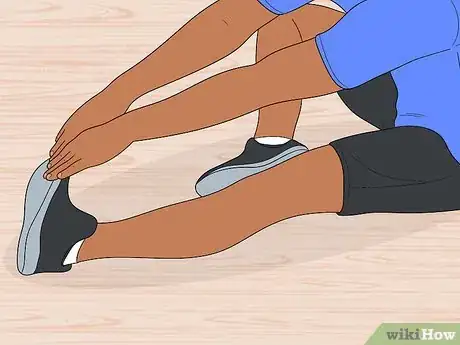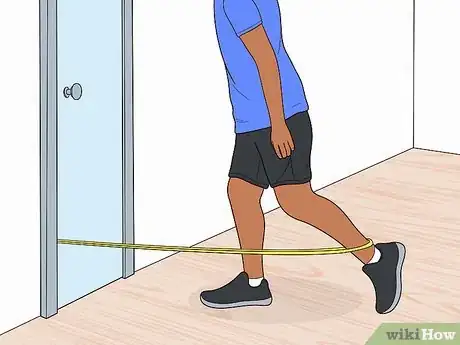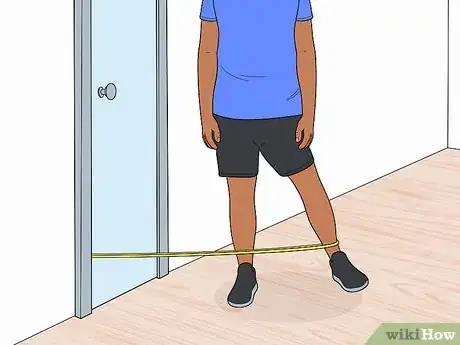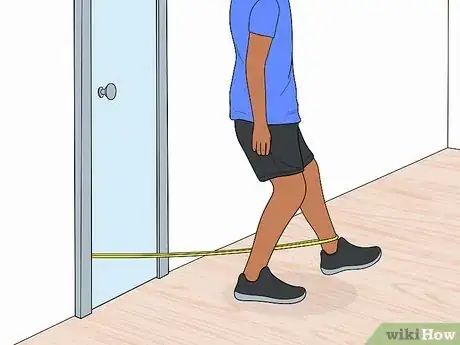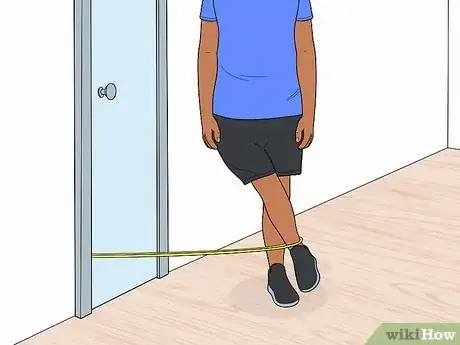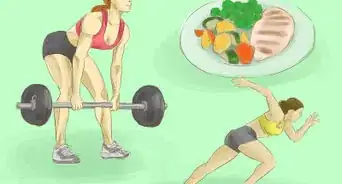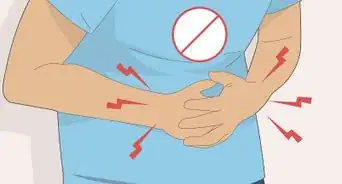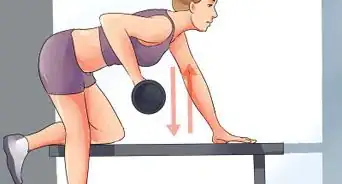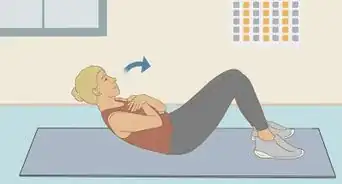This article was co-authored by Monica Morris and by wikiHow staff writer, Christopher M. Osborne, PhD. Monica Morris is an ACE (American Council on Exercise) Certified Personal Trainer based in the San Francisco Bay Area. With over 15 years of fitness training experience, Monica started her own physical training practice and gained her ACE Certification in 2017. Her workouts emphasize proper warm-ups, cool-downs, and stretching techniques.
There are 8 references cited in this article, which can be found at the bottom of the page.
This article has been viewed 8,942 times.
Your knees are made of bone, cartilage, and ligaments, so there’s nothing there that you should try to stretch. But they can still feel tight! Fortunately, you can often relieve tightness under your knee in just a few minutes by gently stretching your calf and shin muscles. Building knee stability with a few more simple exercises may also help get rid of that tight feeling.
Steps
Stretching Your Calves and Shins
-
1Loosen your gastrocnemius with a standing calf muscle stretch. Stand roughly 2 paces from a wall and extend your arms at (or just below) shoulder height so that your palms are flat on the wall. Take a small step forward with your right leg and lean your entire body slightly forward so that your left heel just barely lifts off the floor. Slowly lower your left heel to the floor (while keeping your left leg straight) until you feel a stretch in the back of your lower leg.[1]
- Hold the pose for 10-20 seconds, then switch legs. Repeat 2 more times with each leg. Do this once per day.
- To increase the stretch, move a little further back from the wall. To reduce it, move a bit closer. You should feel a slight stretching sensation, not pain!
- Each of your calves have 2 muscles, one of which is the gastrocnemius.
-
2Adapt the standing calf muscle stretch to work your soleus. The soleus is the other muscle (along with the gastrocnemius) in each of your calves. To target it, make a single minor adjustment to the calf muscle stretch: bend your left knee very slightly when putting your heel down.[2]
- Once again, do the stretch 3 times per leg, for 10-20 seconds each time, once per day.
Advertisement -
3Try a seated calf stretch with a belt or strap. Sit on the floor with your left leg extended and your right leg in a comfortable position. Hold a belt, strap, or rolled-up towel in both hands and loop it over the ball of your left foot. Keep your left knee straight as you pull gently on the belt, strap, or towel, until you feel your calf stretching slightly.[3]
- Hold the pose for 20-30 seconds, switch legs, and repeat 2 more times for each leg, once per day.
- Don’t use an exercise band or other elastic band for this stretch. Use an item that doesn’t stretch or flex.
-
4Do a set of chair-aided calf raises for gentle stretching. Stand with your feet shoulder-width apart and your hands grasping the back of a sturdy chair. While keeping your right foot flat on the floor, lift your left heel until you feel a slight calf stretch, then lower it. Repeat the lift 9 more times, then switch legs.[4]
- Do this stretch once per day.
- Lift only your heel. Keep the ball of your foot on the floor.
- This is a great calf stretch for everyone, but it’s particularly manageable if you have balance issues.
-
5Move on to calf raises on stairs if you’re ready. Stand on the first step with your heels over the edge—hold onto the handrail if there is one! Lift up both heels so that you’re on the balls of your feet, then slowly lower down until your heels are slightly below the height of the step. Do 10-20 total repetitions (reps), once per day.[5]
- While more complex than chair-aided calf raises, this variation also stretches the muscles at the front of your lower leg.
- Don’t do this stretch if you have balance issues.
-
6Take exaggerated heel-to-toe steps to stretch your shins. Take normal-sized walking steps, but focus on the contact your foot makes on the ground. Make sure the back of your heel hits the ground first, then continue along your entire foot until your toes are curled forward and make the last contact with the ground.[6]
- Go once back and forth across an average-sized room, once per day.
- Take slow steps when you first try this, so you can make sure you’re making full foot contact and can feel the stretch in your shins. You can walk more quickly once you get the hang of it.
-
7Try a simple standing shin stretch for surprisingly effective results. Stand upright with your feet hip-width apart. Step back with your left foot so that it’s perpendicular to the floor and only the tips of your toes are touching the floor. Keeping your toes in place, slowly press your left ankle forward until you feel a gentle stretch in your shin.[7]
- Hold the pose for 10-20 seconds, switch feet, and repeat 2 more times per foot, once per day.
Increasing Knee Stability
-
1Isolate the back of your knee with a seated knee stretch. Sit upright with your left foot extended and your right leg bent so that the sole of your right foot is against your left knee or upper calf. Reach forward with both hands and touch either your left shin or toes (depending on your flexibility). Flex your knee downward and try to touch the back of your knee to the floor for 2 seconds.[8]
- Do 10-20 reps per leg, once per day.
- To increase the stretch, rotate your hips forward just a bit so your tailbone is slightly elevated off the floor.
- Aim to feel only gentle stretching at the back of your knee. Don’t try to contact the floor with the back of your knee if it causes pain.
-
2Start a series of 4 knee stabilization exercises with a fitness band. Loop an elastic fitness band around your left ankle, then either tie the ends around a metal pole or tie a knot in them and shut them in a door. Stand facing the door or pole so that the band is taut. Slowly kick your left leg back a few inches/centimeters, hold for 2 seconds, then release.[9]
- Do 10-20 reps, once per day. Move onto the next exercise in this series before switching legs.
-
3Turn 90 degrees and continue the knee stabilization exercises. Rotate your body so that your left hip is facing the door or pole. Place your feet shoulder-width apart and make sure the fitness band is still taut. Slowly kick your left leg inward a few inches/centimeters for 2 seconds, then release.[10]
- Do 10-20 reps, once per day, then move onto the next maneuver in the series.
-
4Turn once again so that you’re facing away from the door or pole. Put your back to the door or pole while ensuring that the exercise band is still taut. Slowly kick your left leg forward a few inches/centimeters, hold for 2 seconds, and release.[11]
- Once again, do 10-20 reps, one time per day, and proceed to the final exercise in the series.
-
5Rotate 90 degrees one last time to complete the knee stabilization series. Turn so that the hip of your right leg (the one without the fitness band) is facing the door or pole. Slide toward the door or pole a bit if needed so the band is as taut as before. Slowly kick your left leg to your side (away from the door) a few inches/centimeters and hold this position for 2 seconds.[12]
- Do 10-20 reps, once per day, then switch legs and repeat the entire series of 4 knee stabilization stretches.
Expert Q&A
-
QuestionHow do I relieve pain under my knee?
 Monica MorrisMonica Morris is an ACE (American Council on Exercise) Certified Personal Trainer based in the San Francisco Bay Area. With over 15 years of fitness training experience, Monica started her own physical training practice and gained her ACE Certification in 2017. Her workouts emphasize proper warm-ups, cool-downs, and stretching techniques.
Monica MorrisMonica Morris is an ACE (American Council on Exercise) Certified Personal Trainer based in the San Francisco Bay Area. With over 15 years of fitness training experience, Monica started her own physical training practice and gained her ACE Certification in 2017. Her workouts emphasize proper warm-ups, cool-downs, and stretching techniques.
ACE Certified Personal Trainer For that, I recommend hamstring glides. Lie on your back and lift up your knee at a 90° angle, and so is your foot. Take the foot from that angle and rotate it, extending it so that it's straight up above the hip and knee. Then, bring it back down to a 90° angle. That will open up the hamstring and should relieve some of the pain.
For that, I recommend hamstring glides. Lie on your back and lift up your knee at a 90° angle, and so is your foot. Take the foot from that angle and rotate it, extending it so that it's straight up above the hip and knee. Then, bring it back down to a 90° angle. That will open up the hamstring and should relieve some of the pain.
Expert Interview
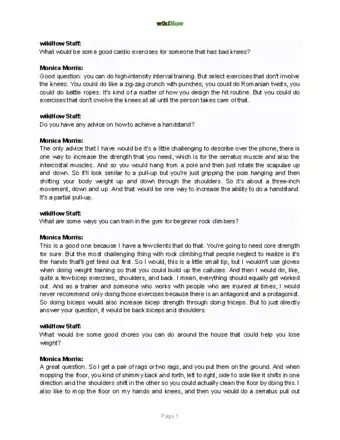
Thanks for reading our article! If you'd like to learn more about stretching out, check out our in-depth interview with Monica Morris.
References
- ↑ https://www.arthritis-health.com/treatment/exercise/knee-stretches
- ↑ https://www.arthritis-health.com/treatment/exercise/knee-stretches
- ↑ https://youtu.be/c_IklPBFMrM?t=80
- ↑ https://orthoinfo.aaos.org/en/recovery/knee-conditioning-program/
- ↑ https://aaptiv.com/magazine/stretches-avoid-shin-splints
- ↑ https://www.sportsinjuryclinic.net/sport-injuries/lower-leg/shin-pain/shin-splints
- ↑ https://www.youtube.com/watch?v=WhU51BhZBT0&feature=youtu.be&t=17
- ↑ https://www.youtube.com/watch?v=dXyHYLOO-fw&feature=youtu.be&t=57
- ↑ https://www.summitmedicalgroup.com/library/pediatric_health/sma_patellofemoral_pain_syndrome_exercises/
- ↑ https://www.summitmedicalgroup.com/library/pediatric_health/sma_patellofemoral_pain_syndrome_exercises/
- ↑ https://www.summitmedicalgroup.com/library/pediatric_health/sma_patellofemoral_pain_syndrome_exercises/
- ↑ https://www.summitmedicalgroup.com/library/pediatric_health/sma_patellofemoral_pain_syndrome_exercises/
